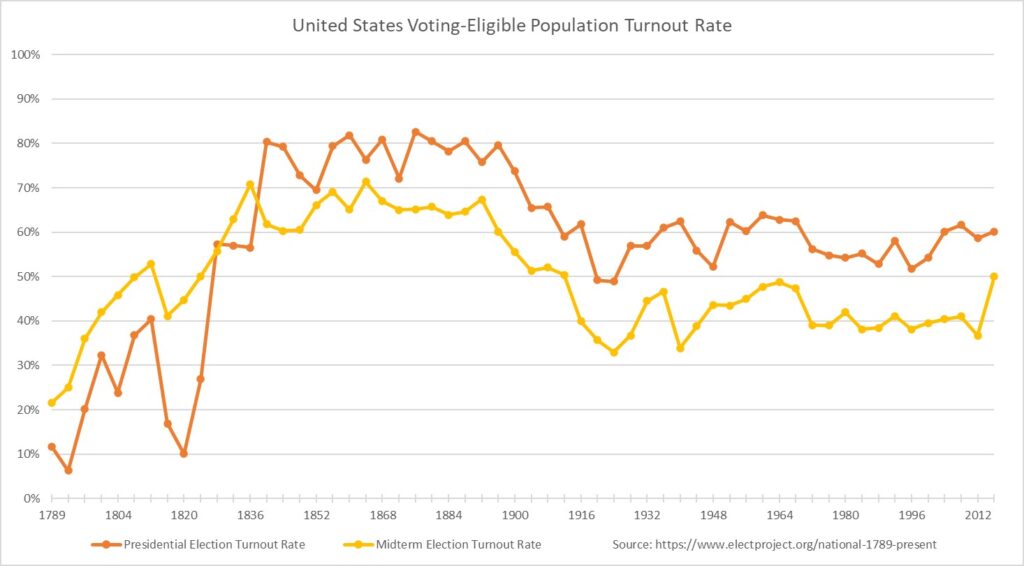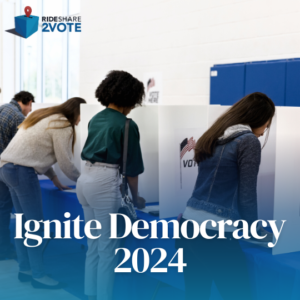The Problem:
Voter Turnout Across America is Virtually Stagnant
At Rideshare2Vote we believe that until the political industry recognizes that every citizen should be voting, Rideshare2Vote will continue to exist and provide solutions for voter mobilization and voter transportation. In the graph at the right, you can see that for decades, the margin of turnout has stayed relatively stagnant.
Read on to see how we are addressing and solving this egregious voter turnout problem in America.

The Solution: Ride2Vote Voter Mobilization and Transportation
Rideshare2Vote, headquartered in Texas, is committed to addressing the chronic issue of low voter turnout among eligible USA citizens.
Our mission is to remove barriers to voting through targeted outreach to uncontacted, non voting, registered liberals, then offering, scheduling and completing a round-trip Ride2Vote for individuals supporting Democrats and Progressive candidates in every election.
Founded just months before the 2018 midterm elections, Rideshare2Vote was created by Democrat activists, campaign veterans, and
former elected officials. Since then, we have expanded from serving 6 counties in Texas to operating in 12 states.
Our flagship program, Ride2Vote, focuses on reaching out to a predominately untouched universe of low propensity and non-voting Democrats and Progressives, making it convenient for them to schedule a Ride2Vote through various channels. For inbound ride requests, we offer mobile apps, web scheduler and toll-free phone service. What sets us apart is that we also complete GOTV, year round, via outbound digital phone contact, text messaging and live calls to stay engaged, invite and schedule voters.
We also partner with campaigns and Voter Registration and GOTV groups. And we can arrange customized voter outreach including – bulk voter transportation, including from college campuses, events, churches and other locations.
Why do we Even Exist?
Rideshare2Vote exists because turnout is key to winning and securing a stable future for democracy. Unfortunately, voter turnout in the US has remained notoriously low for decades. According to the Pew Research Center from 2018 to 2022:
Nationwide, nearly 107.7 million valid votes were cast in the 2022 House elections, representing about 45.1% of the
estimated voting-eligible population, according to a Pew Research Center analysis of official returns from all 50
states. That was down from 48.1% turnout in 2018.
Rideshare2Vote steps in to solve critical voting barriers. Americans overlook how frequently external factors, like child care, elder care, finances, work constraints and voter transportation impact voter turnout.according to USC News, These factors, known as “friction,” include issues like conflicting work schedules, being far away from a polling place, and limited poll opening hours — anything that makes it easier or harder to vote.
Rideshare2Vote Reduces “Friction”
Rideshare2Vote reduces “friction.” Overlooking “friction” in any situation has dire consequences, in voting we would argue more so as it affects the whole country. In a study conducted at USC and reported in USC news:
People who overlooked friction thought that, if you are committed to vote, then you’ll go ahead and do so. That belief
seemed to reduce sensitivity to the challenges of voting. If you overlook friction, you don’t see much need to make voting
highly accessible.
Rideshare2Vote operates in states with the most restrictive voting laws. As of 2023, The Brennan Center for Justice has tracked 34 new laws in 19 states and more than 150 bills pending in state legislatures that it describes as “restrictive voting legislation” article confirms
● There is a large and growing pile of evidence that strict voter ID laws disproportionately impact underserved population and
voters of color.
● Restrictions on Sunday voting — such as those proposed last year in Georgia and Texas — would fall disproportionately on
voters of color.
● Voters of color consistently face longer wait times on Election Day
● Polling place consolidation is also especially harmful for the turnout of racial and ethnic marginalized groups.
Moreover, of course, there is the youth vote. Although turning out at larger levels than ever before, according to the Democracy
Docket from a Tufts University report, historically, underserved or marginalized young people disproportionately face barriers to voting.
“For example, we previously found that youth of color and youth without college experience were more likely to say they did not have transportation to the polls or could not stay in a long voting line.“
Unfortunately, we can go on and on to show the reasons for low voter turnout and reasoning for under-mobilization of large sub-sets of American Voters. Instead, let us show what we do and our outcomes.

Proven Results: Our Outcomes
Rideshare2Vote operates the first and only year round voter mobilization and RIde2Vote program in America – mobilizing and
transporting the communities discussed above. Currently in 12 states, we are aspiring to 16 states for the 2024 presidential election.
Our Ride2Vote Program is one of the only solutions available to increase voter turnout election after election. Our every election
strategy returns the same voters election after election and changes them to every election voters in municipals, special, run-offs, state and national elections. And then we add new mobilized voters every election and the round trip rides go on and on.
Our outcomes speak for themselves. In 2022 alone, we completed 2.2 million touches to 1.2 million voters and showed increases in
USA voter turnout up to 43%. Our complete impact report can be reviewed at this link.
For more information or to speak with an executive team member, please call our office directly at 888-977-2250 or contact us.
RESOURCES:
https://www.brennancenter.org/our-work/research-reports/impact-voter-suppression-communities-color
https://circle.tufts.edu/latest-research/why-youth-dont-vote-differences-race-and-education
https://news.usc.edu/201731/barriers-to-voting-matter-but-americans-overlook-their-impact-study-finds/
https://www.democracydocket.com/opinion/voting-laws-may-present-challenges-to-youth-participation-in-2022/
